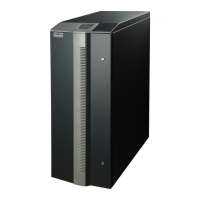After start-up, the following applies:
Operation mode depends on the priority, inverter, rectifier and bypass preferences made by the user and
mains, separate by-pass mains and battery voltages.
Priority and inverter, rectifier and bypass preferences can be set by using the COMMANDS and extra
commands (EXTCMNDS) menus.
If operation in any of these modes is impossible, output voltage will not be present. In this case, loads will
not be fed, and “VSECFLR” message is shown on the LCD instead of operation mode.
3rd1 Bypass Mode
Devices without separate bypass mains input, absorb energy from the mains. In devices with separate
bypass mains input, energy is drawn from the separate bypass mains.
Loads are fed via static bypass line.
Output voltage has the same amplitude, frequency and waveform as the input voltage.
Current drawn by the loads are only limited by the thermal/magnetic switches over the energy flow path.
Voltage, frequency and waveform of the bypass supply shall be in their tolerance limits, and bypass shall
be enabled for the UPS to operate in this mode.
When the upper provisions are met, the UPS works in bypass mode in the following conditions:
During the start-up
If the bypass priority is selected
If the inverter is disabled or blocked
In case of a prolonged overload
You can save energy by selecting the bypass priority. Efficiency in bypass mode is higher than the
efficiency in normal mode. If the bypass priority is selected, the UPS will operate in bypass mode
whenever the frequency/waveform/rms value of bypass mains voltage is in their tolerance limits. If the
bypass voltage goes beyond these limits, the UPS switches into normal operation.
Bypass mode doesn’t provide perfect stability in frequency/waveform/rms value of the output
voltage like in normal mode. Thus, the use of this mode should be carefully executed according to
the level of protection required by the application.
Bypass mode doesn’t provide electronic short circuit protection like in normal mode. If a short
circuit or occurs on the output during bypass operation, the thermal/magnetic protection will act
and all loads will be deenergized.
Prolonged overloads may cause the thermal/magnetic protection act. In this case, all loads will be
deenergized.

